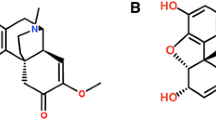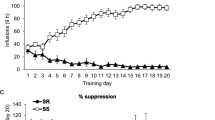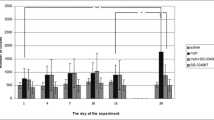Abstract
A low abuse liability is reported for tramadol, an analgesic drug centrally acting through either opioid or nonopioid mechanisms. In this paper, we evaluated the effects of the repeated administration (7 d) of different doses of tramadol (10, 20, and 80 mg/kg, intraperitoneally) on the opioid precursor prodynorphin biosynthesis, in comparison with morphine (10 mg/kg, intraperitoneally), in the rat central nervous system (CNS). Northern analysis showed that morphine and tramadol produced different effects. While morphine caused a down-regulation of prodynorphin mRNA levels in all investigated areas (hypothalamus, hippocampus, and striatum), tramadol did not cause any significant change in the striatum, and did not decrease prodynorphin biosynthesis in the hypothalamus and in the hippocampus, at nontoxic doses (10 and 20 mg/kg). The highest dose of tramadol (80 mg/kg) decreased prodynorphin mRNA levels in the hypothalamus and the hippocampus but not in the striatum. These data give some information on tramadol effects at molecular level in the CNS. They indicate that the alterations of prodynorphin gene expression caused by tramadol and morphine show a different pattern that may be related to the different abuse potential of the two analgesic drugs.
Similar content being viewed by others
References
Bamigbade T. A., Davidson C., Langford R. M., and Stamford J. A. (1997) Actions of tramadol, its enantiomers and principal metabolite, O-desmethyltramadol, on serotonin (5-HT) efflux and uptake in the rat dorsal raphe nucleus. Br. J. Anaesth. 79, 352–356.
Chomczynski P. and Sacchi N. (1987) Single-step method of RNA isolation by acid guanidinium thiocyanate-phenol-chloroform extraction. Anal. Biochem. 162, 156–159.
Cicero T. J., Adams E. H., Geller A., et al. (1999) A post-marketing surveillance program to monitor Ultram (tramadol hydrochloride) abuse in the United States. Drug Alcohol Depend. 57, 7–22.
D'Amour F. E. and Smith D. L. (1941) A method for determining loss of pain sensation. J. Pharmacol. Exp. Ther. 72, 74–79.
Di Benedetto M., D'Addario C., Collins S. L., Izenwasser S., Candeletti S., and Romualdi P. (2004a) Role of serotonin on cocaine mediated effects on prodynorphin gene expression in the rat brain. J. Mol. Neurosci. 22, 213–222.
Di Benedetto M., Feliciani D., D'Addario C., Izenwasser S., Candeletti S., and Romualdi P. (2004b) Effects of the selective norepinephrine uptake inhibitor nisoxetine on prodynorphin gene expression in rat CNS. Mol. Brain Res. 127, 115–120.
Franceschini D., Lipartiti M., and Giusti P. (1999) Effect of acute and chronic tramadol on [3H]-norepinephrine uptake in rat cortical synaptosomes. Prog. Neuro-Psychopharmacol. Biol. Psychiat. 23, 485–496.
Georges F., Stinus L., Bloch B., and Le Moine C. (1999) Chronic morphine exposure and spontaneous withdrawal are associated with modifications of dopamine receptor and neuropeptide gene expression in the rat striatum. Eur. J. Neurosci. 11, 481–490.
Giusti P., Buriani A., Cima L., and Lipartiti M. (1997) Effect of acute and chronic tramadol on [3H]-5-HT uptake in rat cortical synaptosomes. Br. J. Pharmacol. 122, 302–306.
Gunning B., Ponte P., Okayama H., Engel J., Blan H., and Kedes L. (1983) Isolation and characterization of full-length clones for human α-, β- and γ-actin mRNAs: skeletal but not cytoplasmatic actins have an amino-terminal cysteine that is subsequently removed. Mol. Cell. Biol. 3, 787–795.
Kayser V., Besson J.-M., and Guilbaud G. (1991) Effects of the analgesic agent tramadol in normal and arthritic rats: comparison with the effects of different opioids, including tolerance and cross-tolerance to morphine. Eur. J. Pharmacol. 195, 37–45.
Koob J. F. and Le Moal M. (1997) Drug abuse: hedonic homeostatic dysregulation. Science 278, 52–58.
Lee C. R., McTavish D., and Sorkin E. M. (1993) Tramadol. Drugs 46, 313–340.
McClung C. A., Nestler E. J., and Zachariou V. (2005) Regulation of gene expression by chronic morphine and morphine withdrawal in the locus ceruleus and ventral tegmental area. J. Neurosci. 25, 6005–6015.
Miranda H. F. and Pinardi G. (1998) Antinociception, tolerance, and physical dependence comparison between morphine and tramadol. Pharmacol. Biochem. Behav. 61, 357–360.
Mocchetti I., Ritter A., and Costa E. (1989) Down-regulation of proopiomelanocortin synthesis and beta-endorphin utilization in hypothalamus of morphine-tolerant rats. J. Mol. Neurosci. 1, 33–38.
Murano T., Yamamoto H., Endo N., et al. (1978) Studies of dependence on tramadol in rats. Arzneim.-Forsch./Drug Res. 28, 152–158.
Nestler E. J., Hope B. T., and Widnell K. L. (1993) Drug addiction: a model for the molecular basis of neural plasticity. Neuron 11, 995–1006.
Nestler E. J. (1992) Molecular mechanisms of drug addiction. J. Neurosci. 12, 2439–2450.
Nestler E. J. (2001) Molecular basis of long-term plasticity underlying addiction. Nat. Rev. Neurosci. 2, 119–128.
Preston K. L., Jasinski D. R., and Testa M. (1991) Abuse potential and pharmacological comparison of tramadol and morphine. Drug Alcohol Depend. 27, 7–17.
Przewlocka B., Turchan J., Lason W., and Przewlocki R. (1996) The effect of single and repeated morphine administration on the prodynorphin system activity in the nucleus accumbens and striatum of the rat. Neuroscience 70, 749–754.
Raffa R. B., Friderichs E., Reimann W., Shank R. P., Codd E. E., and Vaught J. L. (1992) Opioid and non opioid components independently contribute to the mechanism of action of tramadol, an ‘atypical’ opioid analgesic. J. Pharmacol. Exp. Ther. 260, 275–85.
Raffa R. B. and Friderichs E. (1996) The basic science aspect of tramadol hydrochloride. Pain Rev. 3, 249–271.
Raffa R. B., Friderichs E., Reimann W., et al. (1993) Complementary and synergistic antinociceptive interaction between the enantiomers of tramadol. J. Pharmacol Exp. Ther. 267, 331–340.
Romualdi P., Lesa G., Donatini A., and Ferri S. (1995) Long-term exposure to opioid antagonists up-regulates prodynorphin gene expression in rat brain. Brain Res 672, 42–47.
Romualdi P., Lesa G., and Ferri S. (1991) Chronic opiate agonists down-regulate prodynorphin gene expression in rat brain. Brain Res. 563, 132–136.
Sacerdote P., Bianchi M., Manfredi B., and Panerai A. E. (1997) Effects of tramadol on immune responses and nociceptive thresholds in mice. Pain 72, 325–330.
Scott L. J., and Perry C. M. (2000) Tramadol: a review of its use in perioperative pain. Drugs 60, 139–176.
Tjon G. H. K., Voorn P., Vanderschuren L. J., et al. (1997) Delayed occurrence of enhanced striatal prodynorphin gene expression in behaviorally sensitized rats: differential long-term effects of intermittent and chronic morphine administration. Neuroscience 76, 167–178.
Uhl G. R., Ryan J. P., and Schwartz J. P. (1988) Morphine alters preproenkephalin gene expression. Brain Res. 459, 391–397.
Valle M., Garrido M. J., Pavon J. M., Calvo R., and Troconiz I. F. (2000) Pharmacokinetic-pharmacodynamic modeling of the antinociceptive effects of main active metabolites of tramadol, (+)-O-desmethyltramadol and (−)-O-desmethyltramadol. J. Pharmacol. Exp. Ther. 293, 646–653.
Van Ree J. M., Gerrits M. A. F. M., and Vanderschuren L. J. (1999) Opioids, reward and addiction: an encounter of biology, psychology, and medicine. Pharmacol. Rev. 51, 341–396.
Zachariou V., Bolanos C. A., et al. (2006) An essential role for DeltaFosB in the nucleus accumbens in morphine action. Nat. Neurosci. 9, 205–211.
Author information
Authors and Affiliations
Corresponding author
Rights and permissions
About this article
Cite this article
Candeletti, S., Lopetuso, G., Cannarsa, R. et al. Effects of prolonged treatment with the opiate tramadol on prodynorphin gene expression in rat CNS. J Mol Neurosci 30, 341–347 (2006). https://doi.org/10.1385/JMN:30:3:341
Received:
Revised:
Accepted:
Issue Date:
DOI: https://doi.org/10.1385/JMN:30:3:341




